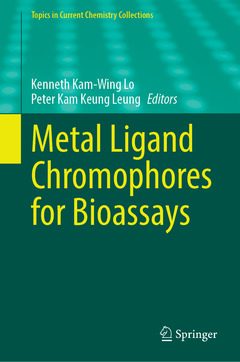Description
Metal Ligand Chromophores for Bioassays, 1st ed. 2023
Topics in Current Chemistry Collections Series
Coordinators: Lo Kenneth Kam-Wing, Leung Peter Kam-Keung
Language: English
Subjects for Metal Ligand Chromophores for Bioassays:
Keywords
Metal Ligand Chromophores for Bioassays
Publication date: 11-2023
243 p. · 15.5x23.5 cm · Paperback
Publication date: 11-2023
243 p. · 15.5x23.5 cm · Paperback
Metal Ligand Chromophores for Bioassays
Publication date: 11-2022
243 p. · 15.5x23.5 cm · Hardback
Publication date: 11-2022
243 p. · 15.5x23.5 cm · Hardback
Description
/li>Contents
/li>Biography
/li>Comment
/li>
The series Topics in Current Chemistry Collections presents critical reviews from the journal Topics in Current Chemistry organized in topical volumes. The scope of coverage is all areas of chemical science including the interfaces with related disciplines such as biology, medicine and materials science. The goal of each thematic volume is to give the non-specialist reader, whether in academia or industry, a comprehensive insight into an area where new research is emerging which is of interest to a larger scientific audience.
Each review within the volume critically surveys one aspect of that topic and places it within the context of the volume as a whole. The most significant developments of the last 5 to 10 years are presented using selected examples to illustrate the principles discussed. The coverage is not intended to be an exhaustive summary of the field or include large quantities of data, but should rather be conceptual, concentrating on the methodological thinking that will allow the non-specialist reader to understand the information presented. Contributions also offer an outlook on potential future developments in the field.
Chapters ?Metal Peptide Conjugates in Cell and Tissue Imaging and Biosensing?, ?Luminescent Metal Complexes as Emerging Tools for Lipid Imaging? and ?Determination and Imaging of Small Biomolecules and Ions Using Ruthenium(II) Complex?Based Chemosensors? are available open access under a CC BY 4.0 License via link.springer.com.
Luminescent metal complexes as photochemical and biomedical tools.- Luminescent metal complex peptide conjugates for super resolution imaging.- Optical markers for polar lipids in live cells.- Time-gated luminescence detection of enzymatically produced small molecules.- DNA binding and imaging using luminescent transition metal complexes.- Metal complexes for phosphorescence sensing of biological metal ions.- Near infra-red emitting lanthanide complexes.- Biosensors and chemosensors for highly reactive molecules, environmental pollutants, and imaging.
Professor Kenneth Kam-Wing Lo obtained his B.Sc. (1993) and Ph.D. (1997) degrees at The University of Hong Kong. From 1997 to 1999, he worked as a Croucher Foundation Postdoctoral Research Fellow at the Inorganic Chemistry Laboratory of the University of Oxford. He joined the Department of Biology and Chemistry (currently Department of Chemistry) of City University of Hong Kong as Assistant Professor in 1999 and was promoted to Professor in 2011. He received The APA Prize for Young Scientist from The Asian and Oceanian Photochemistry Association in 2005 and The Distinguished Lectureship Award from The Chemical Society of Japan in 2011. He was one of the Chairs of the Gordon Research Conference Metals in Medicine 2018 and the Chair of the 23rd International Symposium on the Photochemistry and Photophysics of Coordination Compounds (ISPPCC 2019). He was awarded a Croucher Senior Research Fellowship from the Croucher Foundation in 2015. His research interest is the utilization of luminescent inorganic and organometallic transition metal complexes as biomolecular and cellular probes, with a focus on the development of intracellular sensors, photofunctional labels, bioimaging reagents, bioorthogonal probes, and activatable photosensitizers for photodynamic therapeutic applications.
Builds on the reputation and historical significance of the Topics in Current Chemistry book series Presents comprehensive reviews of established and emerging topics in modern chemical research Supervised by Editors and an Editorial Board of world-leading chemists
© 2024 LAVOISIER S.A.S.




